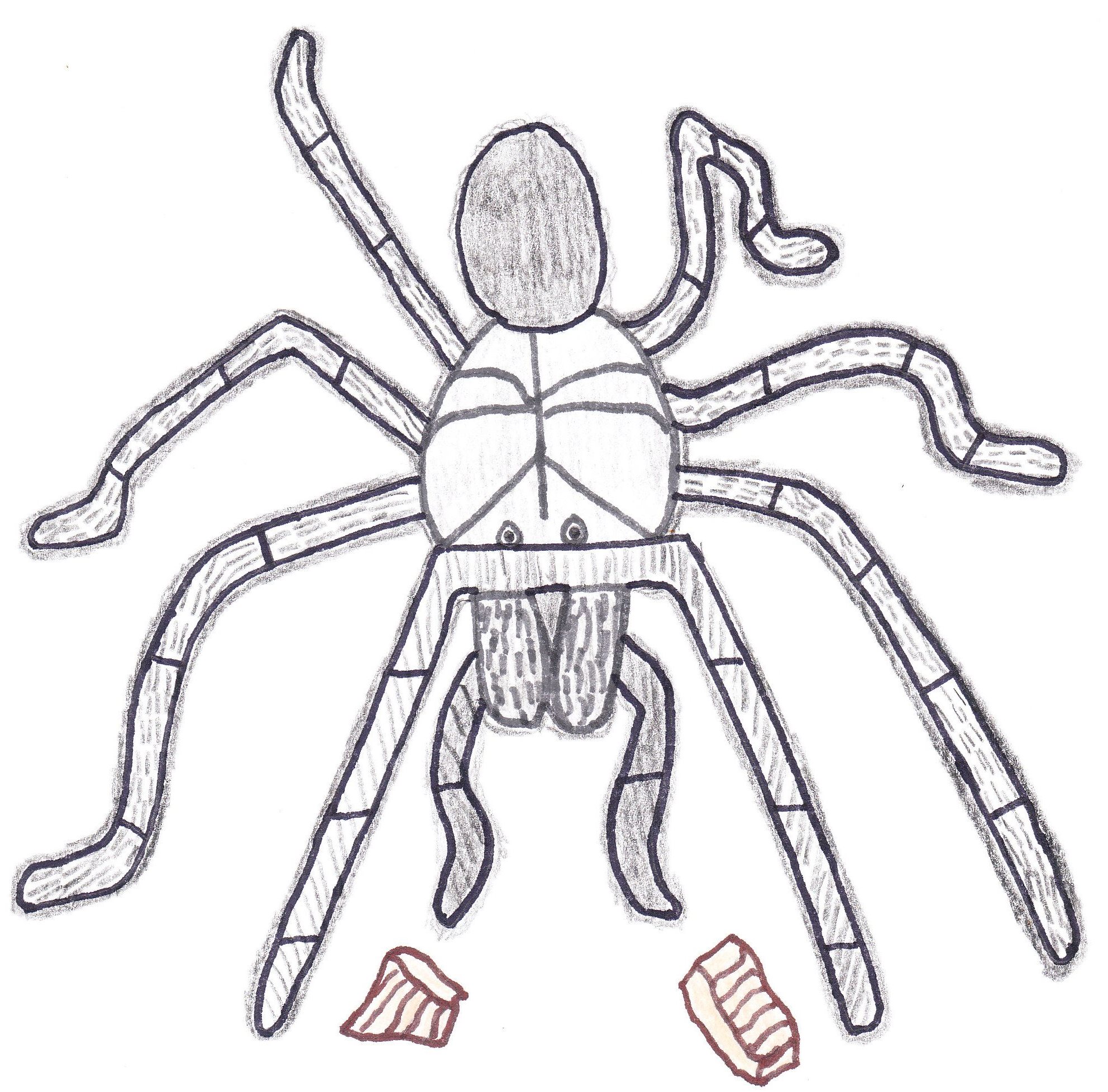
Spider Solitaire is a challenging but fun form of Solitaire. As such, it can be quite rewarding when the player manages to win the game by completely clearing the center layout or tableau. Spider Solitaire uses two standard 52 card decks thoroughly shuffled together.
As this solitaire game consists of attempting to play cards in sequences, it helps to know the
specific ordering of the cards. The cards in the deck, as used when playing Spider are as follows (from high to low); King, Queen, Jack, 10, 9, 8, 7, 6, 5, 4, 3, 2, Ace.
Setup: The setup for playing a game of Spider solitaire consists of a tableau consisting of ten rows of cards, some face-down and others face-up. To create the initial layout or tableau the player deals 10 individual rows of cards. The first four rows (at the left side of the layout) consist of five face-down and overlapping cards. The remaining six rows consist of four face-down cards. After the player has dealt these 10 rows
as described, he then deals one face-up card on the top of each row.
Lastly, the player places the remainder of the deck (consisting of 50 cards) face-down near the layout. After this layout has been created, play can begin.
The object of the game is to completely clear out the layout by creating 8
foundation piles consisting of an entire sequence of cards from Ace to
King, all cards in that sequence being of the same suit. These eight foundation piles are usually placed below the layout. However, players do not play to these foundation piles, rather, once a full, uninterrupted sequence of face-up cards is found at the bottom of one of the piles, that stack is then moved to it's own foundation pile. After creating a foundation pile, the cards from that pile should be turned over as the cards are now considered out of play.
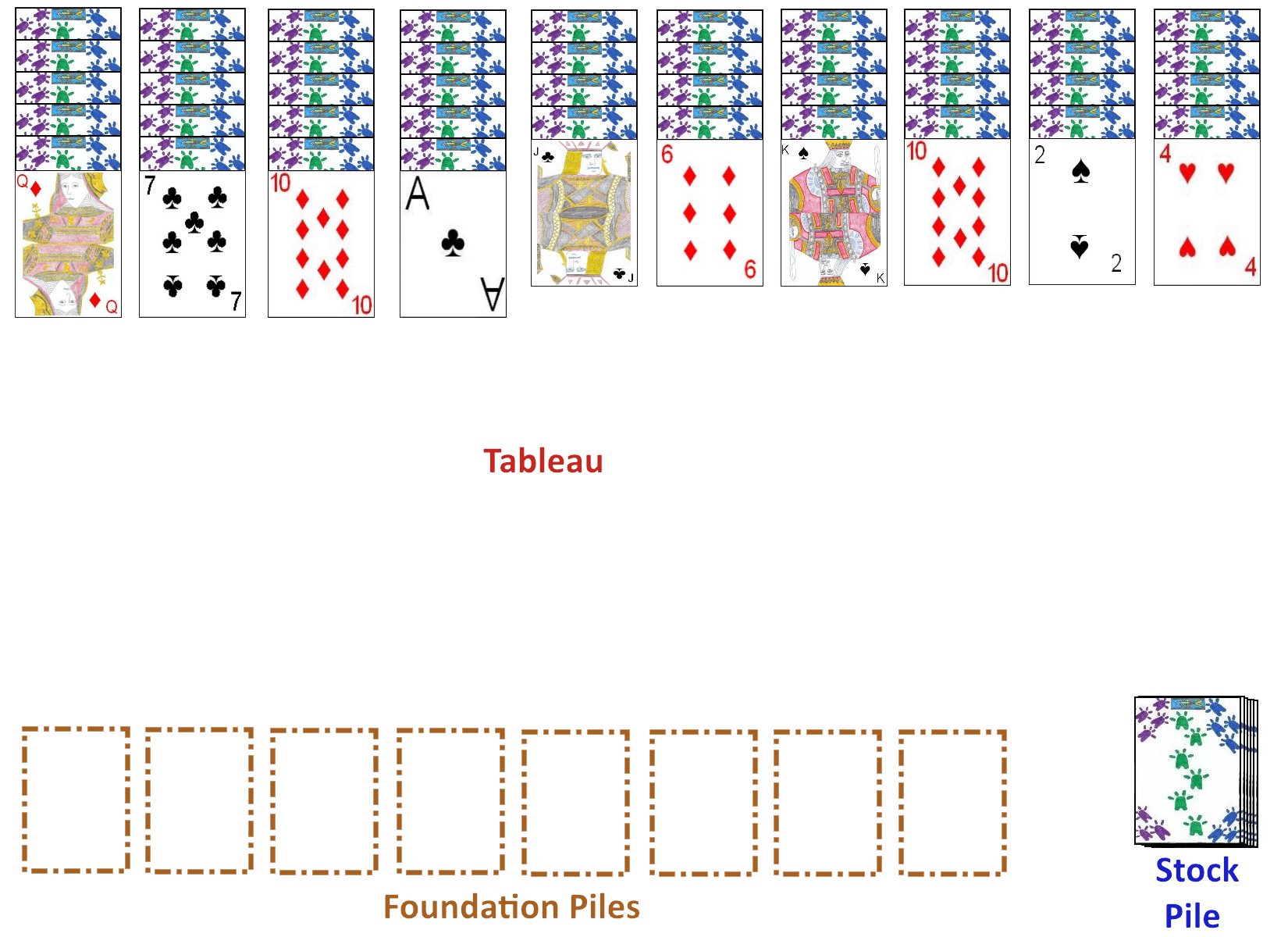
Thus, the player attempts to arrange such a sequence in one row of the layout from King down to Ace, all in the same suit. As soon as he is able to create such a sequence, and the bottom card of the sequence is the bottom card of a row, he can remove the entire row, placing the sequence in it's own foundation pile. In order to create such an unbroken sequence, however, the player will need to move cards around on the layout. There are a few rules on how cards can be moved within the layout. The bottom face-up card in a row can be moved onto the bottom of another if the card it is played on is exactly one rank lower than the card it is played on. Cards can be moved in this way regardless of their suit. A sequence of multiple cards can also be moved to another row as long as every card moved is of the same suit and in descending numerical sequence. The card this entire sequence is played on does not need to be of that same suit but does need to be one card higher than the highest card in the sequence moved. Thus, the entire stack of descending sequence cards is moved on top of that card. As indicated previously, if a player manages to create an entire sequence from Ace to King of cards of the same suit, and the bottom card of the sequence (the Ace) is the bottom card of a row, he may remove the entire sequence and place it on one of the foundation piles.
If the player manages to remove or move all the face-up cards in a row, with one of the originally dealt face-down cards now
the top card of that pile, the player may turn this card over, exposing it, to become the new top card of that pile. Also, if a player, through legal moves manages to remove all the cards from a specific row, he may move any card or
sequence of cards (all in the same suit) to this empty space.
If a player has no more available moves on the layout (or elects not to make further moves with the current configuration of the layout) and there is cards remaining in the undealt stack, he then deals one face-up card from the stock to the top of each row. However, cards may not be dealt this way from the stock if there are any unfilled empty rows, so before doing so, the player
must fill this empty space with another card or cards from the layout.
The game can end in either of two ways. If the player manages to clear out the entire tableau, having created eight complete sequences, from Ace to King, and playing them to the foundation piles, he is said to have won the game. However, alternatively, if the player deals the last of the cards from the stock onto the layout and there are no more legal moves in the layout, the game ends and the player is considered not to have won this game. However, if keeping score, the player does earn a score of one point for each card he has managed to remove from the layout in complete sequences as played to a foundation pile. The odds of successfully getting all cards cleared to the foundation piles is approximately 5%.
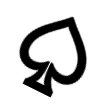 One Suit Spider
One Suit Spider: As this game can be quite challenging, variants have been created to make the game easier to win. One such option is Spider with one suit. In electronic versions of Spider Solitaire, this is usually represented by all the cards being of the same suit
(usually the suit of Spades). As this would be largely impractical using actual decks of cards (eight decks would be needed to
extract the necessary cards to create a deck with 104 cards all of the same suit), the basic rules of the game can be modified somewhat to simulate this.
Thus, in this version, there is no requirement for cards to be of the same suit when creating any sequences. Thus, any unbroken sequence of cards from Ace to King can completely removed from the layout and placed in a foundation pile when created. In addition, when moving a stack of cards from one column on the layout to another, the cards need not be in the same suit, they only need be in an unbroken sequence, and, as usual the card they are played in must be one rank higher than the rank of the top and highest card in this
sequence. As can be imagined, this variant is considerably easier to win.
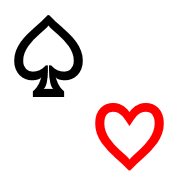 Two Suit Spider
Two Suit Spider: Very similar to one suit spider is two suit spider. In this version, only two suits are represented in the game (i.e. Hearts and Spades). Again, as this would be somewhat impractical to create a 104 card deck consisting of only two suits, modifications can be made to the rules for the standard game to simulate playing in this way.
In this variant, in order to complete and remove a sequence from the tableau from Ace to King, the requirement is that every card in the
sequence be of the same color (i.e. all black suited cards or all red suited cards). Similarly, in moving a smaller sequence of cards from one row to another, the entire sequence need not be of the same suit, but does need to be all of the same color. As in the one suited version, this game is also somewhat easier to win than the standard four suit variation as described above.
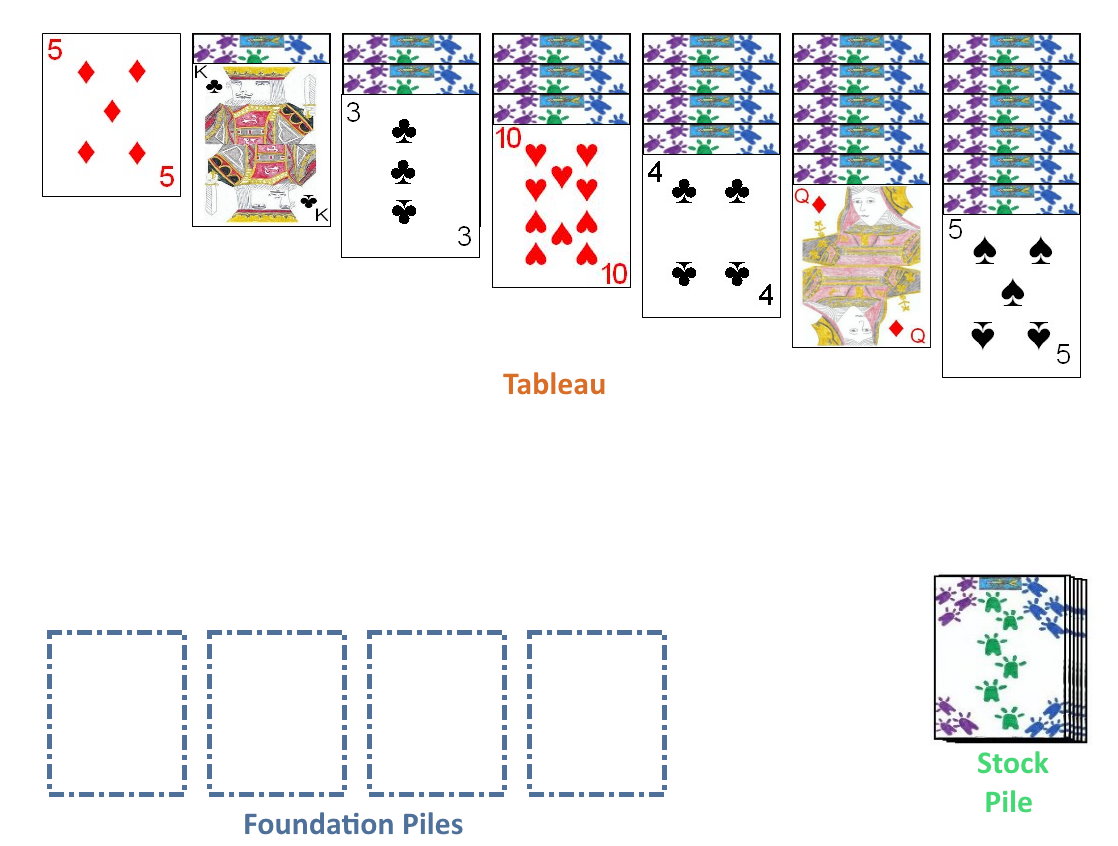 Spiderette
Spiderette: Spiderette is a solitaire game similar to Spider, however
in Spiderette only a single 52 card deck is used for play instead of the double deck as used in normal Spider. The ranking of the cards in Spiderette is the same as in Spider, and is thus, from high to low; Ace, King, Queen, Jack, 10, 9, 8, 7, 6, 5, 4, 3, 2.
To begin, after the deck is thoroughly shuffled and cut, the player deals the initial layout, which is as follows. The dealer deals seven columns of face-down cards. The first column consists of one such card, the second columns two cards, all the way to the last column which contains seven cards. In each row, the cards should be placed on top of each other such that they partially overlap, so all cards underneath can at least be partially seen. The player places the remainder of the deck in a neat, face-down pile to the side, as the stock. After these seven rows of cards are dealt, the player should then turn over to expose the bottom card in each row of cards.
Gameplay is very similar to Spider, with the player attempting to create a full descending sequence of cards from King to Ace, all of the same suit. As the player manages to create such a full sequence in the layout, these cards are then removed and placed in a foundation pile, which is unused for the remainder of the game. The following are the legal moves that can be made by the player during the game:
- If the current card at the top of any sequence is of the next lower in rank as the top card in another column, the card can be moved from it's current location and placed on top of that card in the other pile, regardless of the suits of the cards. It should be placed in such a way that the previous cards in the layout can still be viewed in the layout.
- A sequence of descending cards can also be moved, if this descending sequence is all of the same suit and at the bottom of a column in the layout and the card this sequence is placed on is the next higher than the top card in the sequence so moved. The card which this sequence of cards is moved on to does not have to be of the same suit as the suit of the cards from the sequence, however.
- If cards are removed from a column exposing a face-down card, this card may immediately be flipped over in it's place. This care may be placed as appropriate on the layout.
- If the last card from a columns is cleared, a single card or a sequence of cards (all of the same suit) may be moved from the end of another column to fill this spot.
- As indicated previously, if a full descending sequence of cards is created, from King to Ace, that entire sequence may be removed and placed face-down to fill one of the four foundation piles.
- If the player has no more available moves and the stock pile still has more cards remaining, the player may deal a card to each column. This new card should be dealt in such a way so that the cards above it in the layout can be seen. This new card is considered the new bottom card in that layout.
The game is considered won if the player manages to remove all four sequences of cards from King to Ace from the layout, filling each of the four foundation piles. As this game can be rather difficult to actually win (approximately a 1% probability), alternative versions are also played (as in standard Spider Solitaire), in which suits do not matter in the creation of the sequences (One Suit Spiderette) or in which such a Sequence may be removed if the cards are all of the same color (Two Suit Spiderette).
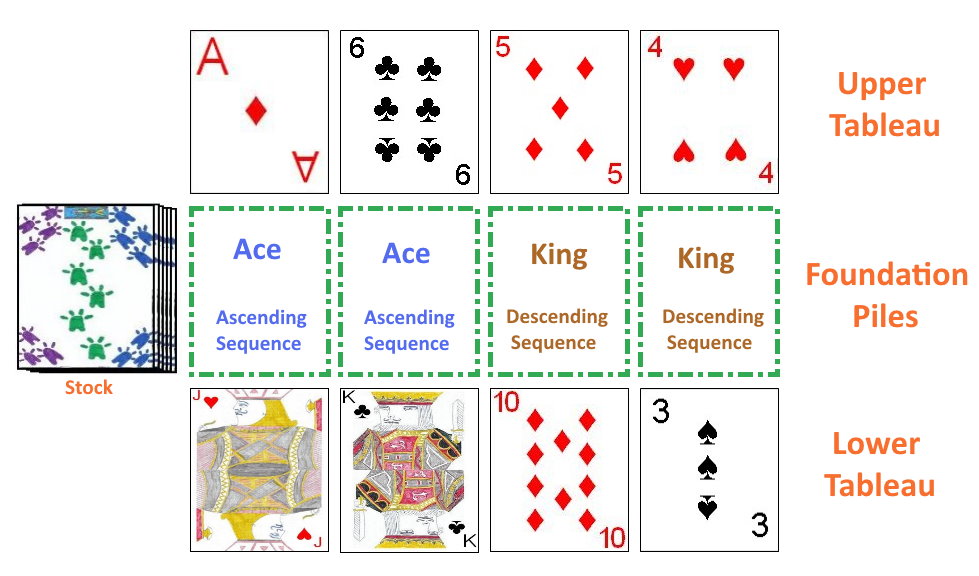 Little Spider
Little Spider: Despite the name of this Solitaire variant, Little Spider has more in common with certain versions of Klondike. However, because of it's name, the rules for Little Spider will be described on this page.
Little Spider uses one standard 52 card deck. The sequence ranking of the cards as used in Little Spider are as follows, from highest to lowest: King, Queen, Jack, 10, 9, 8, 7, 6, 5, 4, 3, 2, Ace.
To begin the game the deck should be thoroughly shuffled by the player. After the shuffle the player then begins creating the layout to be used for the game. To form this layout the player first deals one row of four individual, face-up cards, called the upper tableau. Leaving some space under this upper tableau for the foundation piles, the player then deals out another row of four individual face-up cards to form the lower tableau. He then places the remainder of the deck in a face-down pile to the left of the tableaus as the stock.
The object of Little Spider is to get all 52 cards onto the four foundation piles. A unique feature of this game is that two of the foundations start with the Ace and build in an ascending sequential order to King and the other two foundation piles build down in a descending sequential order from King to Ace. All cards in a particular foundation pile must be of the same suit. Both of the ascending foundation piles, which start with the Ace must be of the same color (red or black) and both of the descending foundation piles (from King to Ace), must be of the same color (red or black). The player is free to choose which colors these will be, but once the first foundation pile is started, the remaining piles must conform to the selected pattern.
There are actually two phases of game play in Little Solitaire. The first phase continues while there are still cards remaining in the deck. After the initial layout is dealt, the player makes any available moves, playing cards from the top of the tableau piles to the foundation piles as able. There are specific rules for playing from the differing tableaus. From the upper tableau, any card can be played to any of the foundations as long as that card is the next card in the appropriate sequence (either ascending or descending). However, plays from the lower tableau are more restrictive. From the lower tableau, a card can only be played to the foundation pile directly above that card, and only if the card is next in the appropriate sequence (either ascending or descending).
Once all available plays have been made, the player then deals eight more cards directly on top of the previous cards of the tableaus. If a tableau space is empty (all cards in that space having been played), the dealer still deals a card to this space. After dealing these next eight cards, play continues as previously, making any available plays from the tableaus to the foundations. During this phase, a card may never be played from one pile in a tableau to another. On the last deal from the deck, there will only be four cards remaining, which should be played on top of the four cards in the upper tableau. After these last four cards are dealt, the rules for the game change and the game enters the second phase.
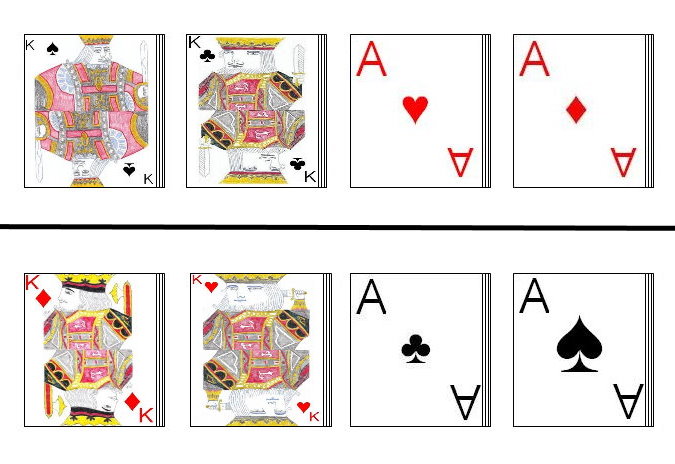
|
| Upon completion of
a hand in Little Spider, the foundation piles might appear in one of these formations
if the player manages to win. |
During this second phase, once the deck has been fully dealt out, rules of play change significantly. During this phase, the top card of any tableau pile can be played to any foundation pile as long as that card is the next in the appropriate sequence and of the same suit. In addition, during this second phase of the game, the top card of a tableau pile can be moved to the top of another tableau if it can legally be played there. A card can thus be played from the top of one tableau pile to
the top of another tableau pile if this card is either one rank higher or lower than the current top card of that tableau. In building to other tableau piles, the suit of the cards in the sequence do not matter. Furthermore, on these piles, an Ace can be played on a King and a King on an Ace. If an empty space is created in a tableau, however, this space is left vacant as no card can be played to that space.
If the player manages to play all the cards to the four foundation piles (two, of the same color in ascending sequence, and two others, of the opposite color in an descending sequence), the player has said to have won the game. The approximate probability of winning Little Spider solitaire is approximately 4%.
Copyright © 2015 CatsAtCards.com. All rights reserved.
 Spider Solitaire is a challenging but fun form of Solitaire. As such, it can be quite rewarding when the player manages to win the game by completely clearing the center layout or tableau. Spider Solitaire uses two standard 52 card decks thoroughly shuffled together.
Spider Solitaire is a challenging but fun form of Solitaire. As such, it can be quite rewarding when the player manages to win the game by completely clearing the center layout or tableau. Spider Solitaire uses two standard 52 card decks thoroughly shuffled together.
 Thus, the player attempts to arrange such a sequence in one row of the layout from King down to Ace, all in the same suit. As soon as he is able to create such a sequence, and the bottom card of the sequence is the bottom card of a row, he can remove the entire row, placing the sequence in it's own foundation pile. In order to create such an unbroken sequence, however, the player will need to move cards around on the layout. There are a few rules on how cards can be moved within the layout. The bottom face-up card in a row can be moved onto the bottom of another if the card it is played on is exactly one rank lower than the card it is played on. Cards can be moved in this way regardless of their suit. A sequence of multiple cards can also be moved to another row as long as every card moved is of the same suit and in descending numerical sequence. The card this entire sequence is played on does not need to be of that same suit but does need to be one card higher than the highest card in the sequence moved. Thus, the entire stack of descending sequence cards is moved on top of that card. As indicated previously, if a player manages to create an entire sequence from Ace to King of cards of the same suit, and the bottom card of the sequence (the Ace) is the bottom card of a row, he may remove the entire sequence and place it on one of the foundation piles.
Thus, the player attempts to arrange such a sequence in one row of the layout from King down to Ace, all in the same suit. As soon as he is able to create such a sequence, and the bottom card of the sequence is the bottom card of a row, he can remove the entire row, placing the sequence in it's own foundation pile. In order to create such an unbroken sequence, however, the player will need to move cards around on the layout. There are a few rules on how cards can be moved within the layout. The bottom face-up card in a row can be moved onto the bottom of another if the card it is played on is exactly one rank lower than the card it is played on. Cards can be moved in this way regardless of their suit. A sequence of multiple cards can also be moved to another row as long as every card moved is of the same suit and in descending numerical sequence. The card this entire sequence is played on does not need to be of that same suit but does need to be one card higher than the highest card in the sequence moved. Thus, the entire stack of descending sequence cards is moved on top of that card. As indicated previously, if a player manages to create an entire sequence from Ace to King of cards of the same suit, and the bottom card of the sequence (the Ace) is the bottom card of a row, he may remove the entire sequence and place it on one of the foundation piles.
 One Suit Spider: As this game can be quite challenging, variants have been created to make the game easier to win. One such option is Spider with one suit. In electronic versions of Spider Solitaire, this is usually represented by all the cards being of the same suit
(usually the suit of Spades). As this would be largely impractical using actual decks of cards (eight decks would be needed to
extract the necessary cards to create a deck with 104 cards all of the same suit), the basic rules of the game can be modified somewhat to simulate this.
One Suit Spider: As this game can be quite challenging, variants have been created to make the game easier to win. One such option is Spider with one suit. In electronic versions of Spider Solitaire, this is usually represented by all the cards being of the same suit
(usually the suit of Spades). As this would be largely impractical using actual decks of cards (eight decks would be needed to
extract the necessary cards to create a deck with 104 cards all of the same suit), the basic rules of the game can be modified somewhat to simulate this.
 Two Suit Spider: Very similar to one suit spider is two suit spider. In this version, only two suits are represented in the game (i.e. Hearts and Spades). Again, as this would be somewhat impractical to create a 104 card deck consisting of only two suits, modifications can be made to the rules for the standard game to simulate playing in this way.
Two Suit Spider: Very similar to one suit spider is two suit spider. In this version, only two suits are represented in the game (i.e. Hearts and Spades). Again, as this would be somewhat impractical to create a 104 card deck consisting of only two suits, modifications can be made to the rules for the standard game to simulate playing in this way.


